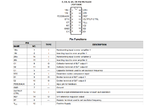abe94
Member level 1
I need to generate a fixed frequency and variable duty cycle PWM signal. Normally I would've used a microcontroller , but due to unavoidable circumstances , I have to use the TL494. I did an extensive study of the datasheet , but there are some doubts which need to be cleared. The picture shows the block diagram of the TL494.

What I've decided to do is to connect the Vref pin to the FEEDBACK pin. According to the datasheet , the Vref pin is a reference voltage source of 5V. I'll put a pot in between the Vref pin and the FEEDBACK pin. That way I can control the voltage input into the FEEDBACK pin from 0 - 5V. If my understanding of PWM generation is correct , the PWM comparator should do its work by comparing the DC signal from feedback and the sawtooth from the oscillator. I have 5 questions.
1. Am I doing this right ? I know the TL494n is supposed to be used as a closed loop system with the feedback coming from the output section of the power supply. I want to re-purpose it as a PWM generator with duty cycle controlled by a pot.
2. What confuses me is what am I supposed to do with the other pins , like the error amplifiers and the DTC . Should I leave them unconnected ? Should I pull them to ground ?
3. I'm using the Vref pin as a voltage source. Is this good practice ? Or should I use a separate 5V source ?
4. I want to get single-ended output from the chip , not push pull. This is kind of a newbie question , but how do I wire up the pins for this mode ?
5. I think instead of FEEDBACK pin , I should use the error amplifiers to provide the control signal to the PWM comparator. Would my original method be alright ? If no , then how can I do that ?
Datasheet : https://www.ti.com/lit/ds/symlink/tl494.pdf
Pin Diagram :


What I've decided to do is to connect the Vref pin to the FEEDBACK pin. According to the datasheet , the Vref pin is a reference voltage source of 5V. I'll put a pot in between the Vref pin and the FEEDBACK pin. That way I can control the voltage input into the FEEDBACK pin from 0 - 5V. If my understanding of PWM generation is correct , the PWM comparator should do its work by comparing the DC signal from feedback and the sawtooth from the oscillator. I have 5 questions.
1. Am I doing this right ? I know the TL494n is supposed to be used as a closed loop system with the feedback coming from the output section of the power supply. I want to re-purpose it as a PWM generator with duty cycle controlled by a pot.
2. What confuses me is what am I supposed to do with the other pins , like the error amplifiers and the DTC . Should I leave them unconnected ? Should I pull them to ground ?
3. I'm using the Vref pin as a voltage source. Is this good practice ? Or should I use a separate 5V source ?
4. I want to get single-ended output from the chip , not push pull. This is kind of a newbie question , but how do I wire up the pins for this mode ?
5. I think instead of FEEDBACK pin , I should use the error amplifiers to provide the control signal to the PWM comparator. Would my original method be alright ? If no , then how can I do that ?
Datasheet : https://www.ti.com/lit/ds/symlink/tl494.pdf
Pin Diagram :
